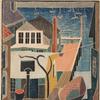Asia Week Exhibition at Koichi Yanagi Oriental Fine Arts - Kokon Biannual ’15
- NEW YORK, New York
- /
- March 11, 2015
The Kokon Biannual ‘15 exhibition will present important and exciting Japanese works of art from the Momoyama through Edo periods. Included are calligraphy and ceramics from the earliest years of what became known as the Rinpa school and striking and evocative paintings of the cherry blossom season, the period symbolic of spring and rebirth in Japanese culture.
Foremost among these works is a rare and beautiful Momoyama period screen depicting blooming cherry blossoms on Mt. Yoshino, painted in Yamato-e style. This screen belongs to a small but significant group of screen paintings from the 16th century.
Also notable is A Poem from the Shin Kokinshū, with calligraphy by Hon’ami Kōetsu (1558-1637) and printed designs by Tawaraya Sōtatsu (?-1643). These artists established the foundation for the tradition of Rinpa art. The year 2015 marks the 400th anniversary of the establishment of Takagamine in 1615, a community founded by Kōetsu on land granted to him by Tokugawa Ieyasu. As such, 1615 is often thought of as the founding year of the Rinpa style. Koichi Yanagi Oriental Fine Arts is proud to display this calligraphy during this meaningful year.
This calligraphy is a fragment from a handscroll of the poetry anthology Shin Kokin wakashū (New Collection of Poems Ancient and Modern, 1205). Many sections of this handscroll were subsequently cut and mounted as hanging scrolls. Other sections of this handscroll are owned by museums and private collectors in Japan.
Other works include a Mino-Iga type, square-shaped water jar, or mizusashi, made during the 16th - 17th century. Square-shaped buckets with handles were common objects in the day-to-day lives of Edo period people. This piece is reminiscent of such buckets, yet despite being made in clay the piece has a remarkably robust and vigorous form. There are few extant examples of square-shaped water jars in clay. This piece is particularly important as it has been in continuous use since it was created in the Momoyama period, making the work especially valuable. The bottom of this water jar has a T-shaped mark. Identical marks have been found on the bottoms of ceramics excavated from the Motoyashiki kiln, proving that this piece was also fired at the same kiln.
A rectangular ceramic tray by Ogata Kenzan (1663-1743), the younger brother of Ogata Kōrin (1658-1716), the founder of the Rinpa school, represents a new type of dish that Kenzan designed. It was made during the time when Kenzan operated his kiln at Nijō Chōjiya, in Kyoto proper. This particular dish is meticulously decorated with a Japanese bush clover motif. The work is emblematic of both Rinpa design as well as innovations in the history of Japanese dining customs.
This year is the bicentennial of the groundbreaking publication Kōrin hyakuzu (One Hundred Pictures by Kōrin), by Sakai Hōitsu (1761-1828). A lacquer tray by Hara Yōyūsai (1769/1772-1845), a frequent collaborator with Sakai Hōitsu, features designs from the Kōrin hyakuzu. This rare work is an exquisite combination of Kōrin’s designs and Yōyūsai’s masterful use of the maki-e technique, which involves sprinkling gold or silver over lacquer. The sources for Yōyūsai’s designs are seldom documented, making this piece exceptionally rare.
Another work depicting cherry blossoms is a hanging scroll by Teisai Hokuba (1770-1884), which shows the townspeople of Edo gathering by a river to celebrate the season. This is the largest hanging scroll known to have been made by the artist and is in exemplary condition.
A .pdf of the catalogue is available by request to Kokon@earthlink.net.
Contact:
Grace GalieKoichi Yanagi Oriental Fine Arts
kokon@earthlink.net




270x400_c.jpg)




















